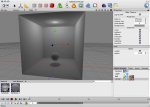- Messages
- 6,547
I agree with Willem  (as usual)
(as usual)
I don't much care about multilayer PSD support. It's nice, but ultimately just a minor issue. I'd love to have the option of baking procedural textures...
Lightmaps can be used in really obvious ways (e.g. baking shadows into terrains) and less obvious ways (e.g. baking ambient occlusion/radiosity into spaceship models so their nooks and crannies are darker).
I might add that a lightmap tends to require a gigantic texture with distinct mappings for every polygon / polygon group in the scene (with the possible exception of those polygons entirely brightly lit and those entirely in darkness) -- although in general the UV mapping is done *before* the lightmapping, so this kind of optimization isn't done in practice (by automatic systems anyway).
I don't much care about multilayer PSD support. It's nice, but ultimately just a minor issue. I'd love to have the option of baking procedural textures...
Lightmaps can be used in really obvious ways (e.g. baking shadows into terrains) and less obvious ways (e.g. baking ambient occlusion/radiosity into spaceship models so their nooks and crannies are darker).
I might add that a lightmap tends to require a gigantic texture with distinct mappings for every polygon / polygon group in the scene (with the possible exception of those polygons entirely brightly lit and those entirely in darkness) -- although in general the UV mapping is done *before* the lightmapping, so this kind of optimization isn't done in practice (by automatic systems anyway).



